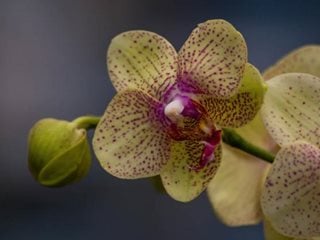My Orchid is Not Blooming
Information on how temperature, light and fertilizer impact an orchid's ability to flower
Photo by: Susanne Nilsson.
Question:Not one of my orchids has rebloomed in over a year. I buy them in flower and they look beautiful for weeks, then they never bloom again. I water once every week to 10 days and fertilize monthly, but they don’t look like they’re even thinking about flowering.
— Sue Stewart, Raleigh, N.C.
| Temperature | Orchids need cooler nights to bloom, try turning the thermostat down by 10 degrees when you go to bed |
| Light | Try placing your orchid in a brighter spot, but if in a south-facing window, filter the light with a shade or curtain |
| Fertilizer | For better flowers, fertilize during the active growing season with a soluble houseplant fertilizer. |
| Repotting | Remove the old potting mix, trim away the oldest roots and sections of the orchid that have lost their leaves or are in decline, and repot with fresh, bark-based potting mix |
Answer:PROVIDE A NIGHTTIME TEMPERATURE DROP
Many orchids flower only once a year, but you are definitely overdue for some payback. When they’re happy, your orchids should rebloom about the same month they flowered when you bought them. Don’t worry, your plants are still alive and growing fine, so you seem to be doing almost everything right. A few minor adjustments should bring them back into flower. Orchids that don’t get cooler nights often refuse to make flower buds. If yours are near a window, they’re probably getting at least a partial temperature drop at night, but that may not be enough. Try turning the thermostat down by at least 10 degrees when you go to bed. Many of your other houseplants will thank you for this as well. Cymbidiums, which need serious cold (35°F to 50°F) at night to set flower buds, are the exception to this rule. Put the little dears outside in late summer to early fall for about six weeks, and they’ll develop buds.
Courtesy of GrowingWisdom.com.
GET THE LIGHT RIGHT
Another important factor in forming flower buds is exposure to light. All the popular orchids - those you find at florist shops and orchid shows - will grow quite happily on most windowsills. A few, notably the lady’s-slippers (paphiopedilums, or “paphs”), will do well with no direct light, in a north window, for instance. Others, such as the cattleyas, need lots of light and a south window. In fact, many cattleyas and cymbidiums are at their best when their leaves are a little on the yellow side; dark green leaves mean they need more sun. Of course, those that need intermediate light are the easiest to please, and that’s one reason for the popularity of moth orchids (phalaenopsis). When everything is to their liking, many phalaenopsis will bloom twice a year.
If you suspect that light is the problem, first try placing your plant in a brighter spot. If a south window is too intense for your particular orchid, soften the light with a curtain or light-filtering shade. If you’ve got a sun lover but no sunny southern exposure, you’ll need artificial light: Hang fluorescent tubes very close to the foliage, or use powerful halide plant lights, that can be placed farther away. If you can move your plants outdoors in the summer, most of them will appreciate the light and fresh air (they’re also much easier to water and fertilize). Just don’t overdo the sunshine. Outdoors, even sun lovers will need some protection. Bright, dappled shade is best, so don’t move them until the trees have fully leafed out and all threat of frost is gone. Shade-loving orchids should be kept in deep shade, and sun lovers will thrive in a spot that gets direct sun either early or late.
FERTILIZE & REPOT
Fertilizer is probably not your problem. Even without any, plants that are well-watered, get plenty of light, and have a day-night temperature difference will flower. But that said, they will flower better if you fertilize them properly. Any soluble houseplant fertilizer like Peters or Miracle-Gro will serve well. Fertilize only during the active growing season, when the sun is strong and the days are long. From mid-December until mid-February, hold off on fertilizing. Repotting your orchids this spring may also improve their chances of flowering. Phalaenopsis, which grow more rapidly than other orchids, should certainly be repotted once a year, at the beginning of their active growth period, when you see fresh new roots or a shoot; some people repot them every time they finish flowering. Orchids with a growing point that creeps along the surface in one direction (cattleyas, oncidiums, and cymbidiums, for example) should be repotted when that tip reaches the edge of the pot. With repotting, bigger isn’t necessarily better. You can put your orchid in the same-size pot or even take it down a size. Just remove the old potting mix, trim away the oldest roots and sections of the plant that have lost their leaves or are in decline, and repot it with new bark-based potting mix. After repotting, resume your watering routine, and as soon as you see new growth, start fertilizing. Your plants will quickly show signs of rejuvenation, and after a few months you should begin to see fresh new flower spikes.





